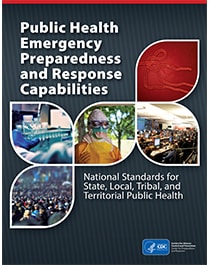Public Health Emergency Preparedness and Response Capabilities: National Standards for State, Local, Tribal, and Territorial Public Health

In 2011, CDC established 15 capabilities that serve as national standards for public health preparedness planning. Since then, these capability standards have served as a vital framework for state, local, tribal, and territorial preparedness programs as they plan, operationalize, and evaluate their ability to prepare for, respond to, and recover from public health emergencies.
In 2017, DSLR began updating the capabilities in response to lessons learned from public health emergency responses, updates to public health preparedness science, revised guidance and resources, findings from internal reviews and assessments, subject matter expert feedback from the practice community, and input from allied federal agencies and professional associations. The capabilities update focused on streamlining language and aligning content with new national standards, updated science, and current public health priorities and strategies. The capabilities also support topics such as pandemic influenza, environmental health, at-risk populations, and tribal populations.
The 2018 Public Health Emergency Preparedness and Response Capabilities: National Standards for State, Local, Tribal, and Territorial Public Health recognizes the maturity and experience jurisdictional public health emergency preparedness and response programs have gained since 2011 and describes the components necessary to advance jurisdictional public health preparedness and response capacity
Download Materials
- Public Health Emergency Preparedness and Response Capabilities: National Standards for State, Local, Tribal and Territorial Public Health (Full Document) – October 2018
- Public Health Emergency Preparedness and Response Capabilities Summary of Changes – October 2018
- Public Health Emergency Preparedness and Response Capabilities Suggested Resources – October 2018
- Public Health Emergency Preparedness and Response Capabilities Infographics – October 2018
Understanding the Capabilities Structure and Composition
Each capability standard comprises capability functions, and each capability function contains specific capability tasks that are supported by multiple capability resource elements.

- Capability Title and Definition – Description of the capability as it applies to state, local, tribal, and territorial public health agencies. Each definition includes a list of potential partners and stakeholders with which jurisdictions may consider working to achieve the capability
- Capability Functions – Critical segments of the capability that must occur to achieve the capability definition
- Capability Tasks – Action steps aligned to one or more capability functions. Capability tasks must be accomplished to complete a capability function
- Capability Resource Elements – Resources a jurisdiction should have or have access to successfully perform capability tasks associated with capability functions. Resource elements are listed sequentially to align with corresponding tasks in each function. While not necessarily listed first, “priority” resource elements are potentially the most critical for completing capability tasks based on jurisdictional risk assessments and other forms of community input. The three categories of capability resource elements are
- Preparedness (P) – Components to consider within existing operational plans, standard operating procedures, guidelines, documents, or other types of written agreements, such as contracts or memoranda of understanding (MOUs)
- Skills and Training (S/T) – General baseline descriptions, competencies, and skills that personnel and teams should possess to achieve a capability
- Equipment and Technology (E/T) – Infrastructure a jurisdiction should have or have access to with sufficient quantities or levels of effectiveness to achieve the intent of any related capability task






















.png)











No hay comentarios:
Publicar un comentario